Texas is home to a wide assortment of owl species, from the more common Barn Owl to the very rare Northern Saw-whet Owl. Depending on where you are looking, you have the potential to see some incredible species. However, some owls in Texas are not as widely recorded due to their own secrecy or limited populations. If you are traveling through or a Texas resident, you might also find yourself searching for the common and lesser-known species of owls in Texas!
All owls are considered raptors. Like a raptor, owls are birds of prey that most frequently hunt small rodents and other creatures. Most owls are active after twilight and during the nighttime hours, but several species come out to hunt during the day, too. If you are interested in locating any of these raptors, you should know that some are more easily recognizable. Plus, others do not call Texas their home all-year-round but might pop in for the breeding season or spend winter there.
The state of Texas has a lot of diverse landscapes, which makes it ideal for a wide variety of owl species. Some of the owls in Texas include the widespread Great Horned Owl and the secretive Eastern Screech-Owl. Most owls in Texas, however, are somewhat at risk due to loss in habitat or other similar issues.

Barn Owl
Scientific Name: Tyto alba
Size: Medium (14-20” long; wingspan 43-47”)
Residency Type: Permanent resident
Barn Owls are incredibly common in North America, perhaps due to their very versatile natures. They live in both rural and suburban areas comfortably. In the daytime, they will make any dark place their resting spot, including barns, dense trees, and caves. They generally prefer to roost and nest 3 meters above ground level. Barn Owls are another example of a bird of prey that mates for life. This type of breeding practice is easier because they are not migratory. In Texas, they are considered permanent residents and are found all over the state. If you are driving on a clear night on an open country road, you have a better chance of spotting this owl. Look out for its distinctive face, which is heart-shaped and somewhat resembles a monkey. Their coloring is also beautiful and distinctive, with a combination of golden tawny and spotted white.

Great Horned Owl
Scientific Name: Bubo virginianus
Size: Large (wingspan 36-60”)
Residency Type: Permanent resident
This powerful species is incredibly iconic. If there is an owl on this list that you will be able to recognize without much help, it will be the Great Horned Owl. It is also one of the most common owls in North America, and Texas is one of its breeding areas. You will be more likely to hear it in fall and winter, around the time its breeding season starts. In Texas, the breeding season is from December to late July. Great Horned Owls use abandoned nests from another raptor, the Red-tailed Hawk. Its ability to adapt in many environments allows it to make its home all over Texas. You probably already know its distinct song, which consists of several bold, rhythmic hoots. It is famous as the ‘hoot’ owl due to this classic sound. Great Horned Owls are often active around dusk to hunt and might be spotted during the day, too.
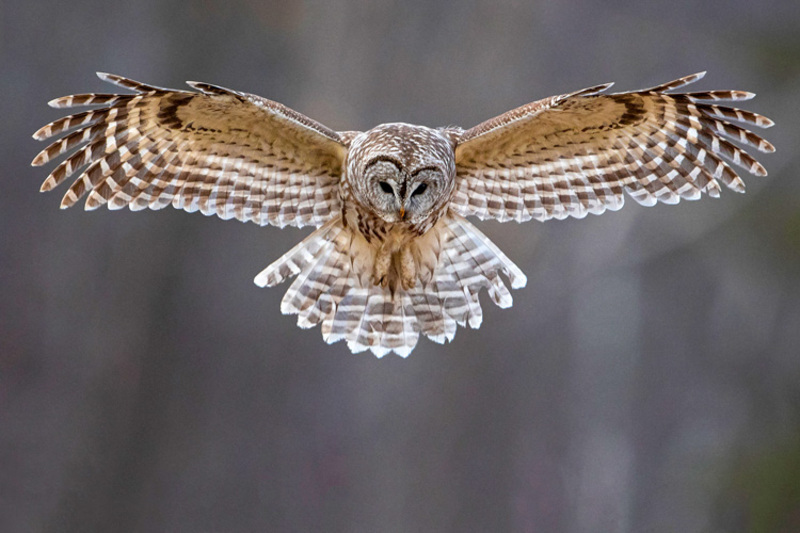
Barred Owl
Scientific Name: Strix varia
Size: Medium (17-24” long; wingspan 50-60”)
Residency Type: Permanent resident
If you have ever been outside and heard someone ask you “Who cooks for you, who cooks for you all!” you may be near a Barred Owl. The silly, but the well-known call of this species makes it very easy to pick out at nighttime. You are more likely to hear them in the fall and winter. Although they prefer being active after dusk, this species might appear in the daylight sporadically. They like to make their homes in large trees in older forests where there are plenty of cavities for nests. Deforestation harms this species, which prefers old-growth forests. The Barred Owl gets its name from its long, barred tail, but also can be recognized from its yellow bill and the horizontal bars on its breast. It also has deep, black eyes on a large face.
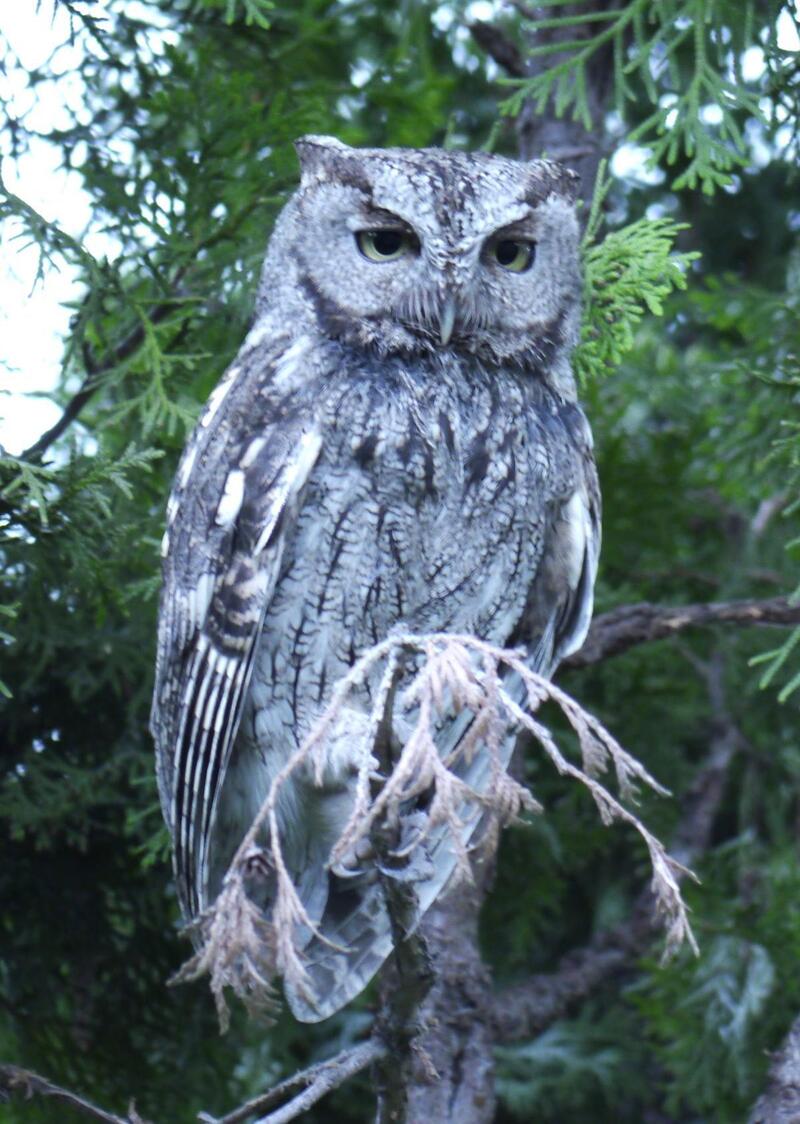
Western Screech-Owl
Scientific Name: Megascops kennicottii
Size: Small
Residency Type: Permanent resident
It has only been since the 1980s that the Western Screech-Owl has been recorded as a separate species of an owl from the Eastern Screech-Owl. Of all the owls in Texas, the Western Screech-Owl might be a difficult one to locate because of this species overlap. The biggest difference between the species is their call, which members of one group can recognize over the other. And the Western Screech-Owl is only seen with a gray color, unlike the Eastern Screech-Owl which can sometimes be reddish-brown. Their homes are often made in wooded canyons and mesquite desert areas, but they also live comfortably in suburban areas.

Eastern Screech-Owl
Scientific Name: Otus asio
Size: Small (wingspan 18-24”)
Residency Type: Permanent resident
With an average weight of 6 ounces, the Eastern Screech-Owl is kind of adorable. This species of owl is often found in habitats ranging from urban gardens to wooded lots. If you hear a drawn-out trill that sounds kind of sad and mournful, you might have an Eastern Screech-Owl near you. This mournful cry often indicates its irritation with an intruder to its territory, so keep an eye out for an angry owl! They are never active during the day but prefer to come out around dusk to hunt a variety of insects and small mammals and fish. In Texas, you are more likely to spot gray-colored Eastern Screech-Owls. But this species is very quiet and quick, which makes sightings hard to come by for most people.
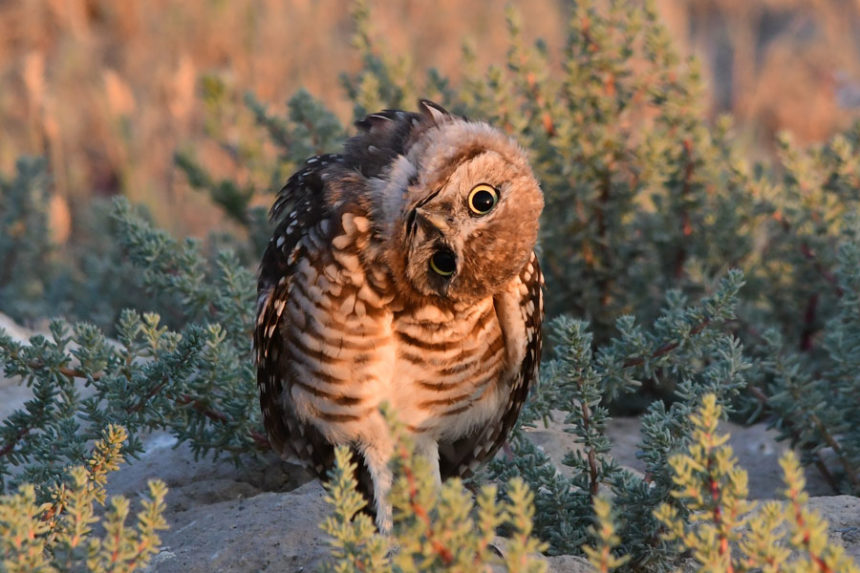
Burrowing Owl
Scientific Name: Speotyto cunicularia
Size: Medium (9” long; wingspan 20-24”
Residency Type: Year-round and winter residents
Burrowing Owls, as you might have guessed from the name, have similar burrowing behavior to prairie dogs. You will find them using other animal’s holes and burrows for their burrows in treeless areas, such as short-grass plains and prairies. They are relatively easy to find because they nest in loose colonies. This species strays from typical owl behavior in another way: they are active both day and night, which along with their ground-dwelling lives, makes them an anomaly in North America. In Texas, the Burrowing Owl frequents the Trans-Pecos and Panhandle areas for breeding. To distinguish this species from other owls, look out for long legs, short tails, white eyebrows, and bright yellow eyes.
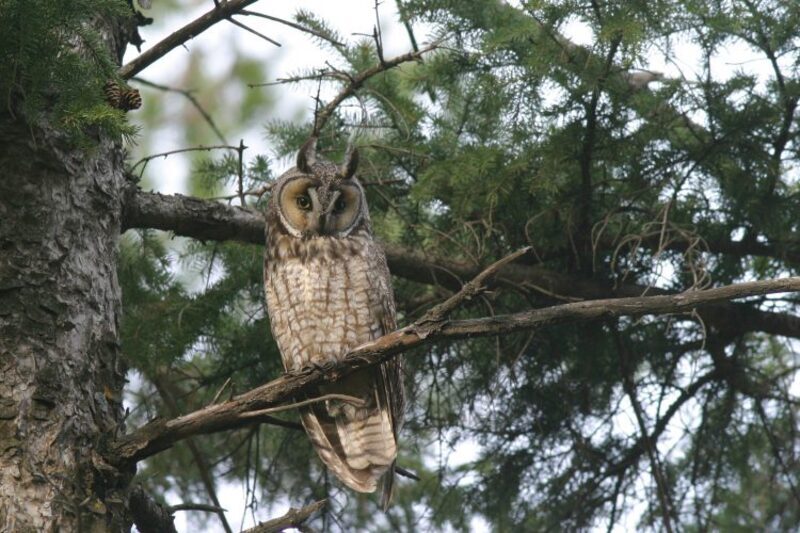
Long-eared Owl
Scientific Name: Asio otus
Size: Medium (14” long)
Residency Type: Occasional winter resident
Sightings of Long-eared Owls are generally rare in Texas, but they might be seen in the northern part of the state on occasion. For the most part, you will find them during the winter months in small colonies. They make homes in wooded areas in the nests of other birds. You can pick the Long-eared Owl out from other raptors by its dark coloration and very long ear tufts. These tufts are not their actual ears but are attached to them. Their faces are a distinct pumpkin-orange color. They mainly vocalize in a single “whooping” sound, although they have catlike and doglike sounds, too.
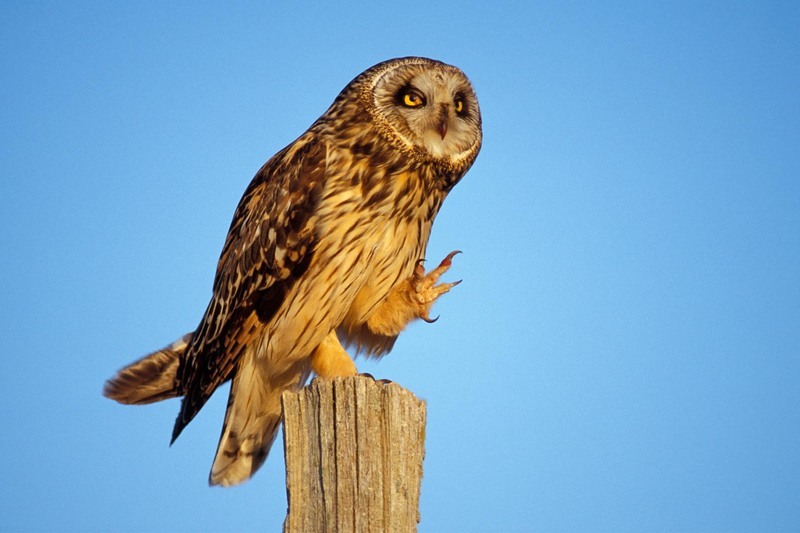
Short-eared Owl
Scientific Name: Asio flammeus
Size: Medium
Residency Type: Occasional winter resident
The Short-eared Owl has a size similar to the American Crow, with a pale to dark brown upper with an off-white underside. It is not a common sight in Texas, because they only come through in the winter months. You can spot a Short-eared Owl from another species by its bright yellow eyes. Their ear tufts are shorter than the Long-eared Owl and are in fact designed for the type of ground camouflage they utilize. They are not the easiest to spot and identify because of their behavior. Instead of roosting in tall trees, they camouflage themselves in tall grasses. They are easily spooked from their hiding spots. For a fool-proof way to spot a Short-eared Owl, you only need to look out for a Northern Harrier in the daylight. This daytime raptor feeds on a similar diet to the Short-eared Owl. After dusk, you can stay in the same spot to check out the hunting behavior of this unique owl species.

Spotted Owl
Scientific Name: Strix occidentalis
Size: Medium
Residency Type: Permanent resident in some areas; fall and winter other locations
Researchers count three different groups of Spotted Owls in North America. In Texas, the Mexican Spotted Owl has been known to make its home in the Guadalupe and Davis Mountains. You will generally see them close to the Mexican border, as most of this subspecies calls Mexico home. Because they prefer old-growth trees and forests, they are considered threatened due to loss of habitat. Their favorite spots are cool locations, whether on the cool side of a cliff or in deep canyons. The Spotted Owl can be recognized by its dark eyes and chestnut-brown color. This species of owl also doesn’t have ear tufts.
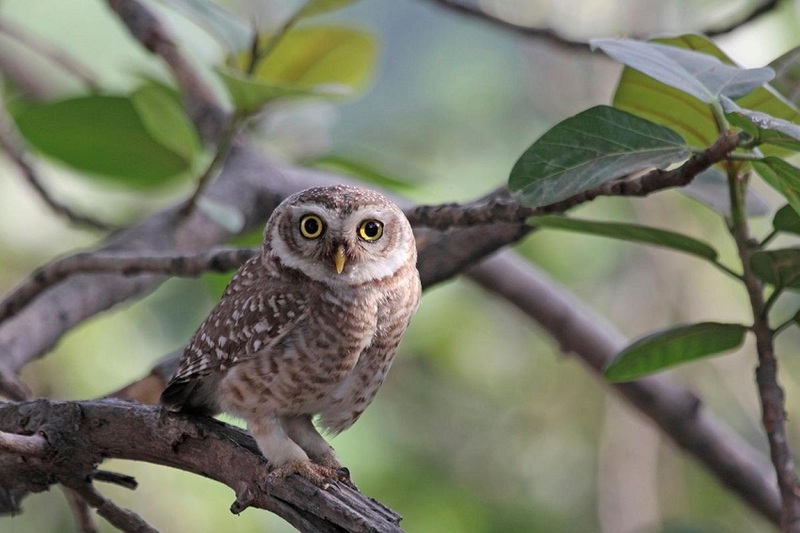
Elf Owl
Scientific Name: Microthene whitneyi
Size: The smallest in North America
Residency Type: Summer resident
If you are situated near the lowered Big Bend region of western Texas or the deep south, you can be on the lookout for the Elf Owl. It is the smallest species of owl, measuring only 5 inches long and weighing between 1 and 2 ounces. It is reddish-brown with a short tail and a V-shaped white strip above its eyes. You will hear the Elf owl more often than you will see it. It makes puppy-like sounds after dusk in early spring that are fairly distinct. Elf owls are pretty consistent with their migration. They like to winter in central Mexico but will return to the western portion of Texas for the breeding season and raising their owlets.
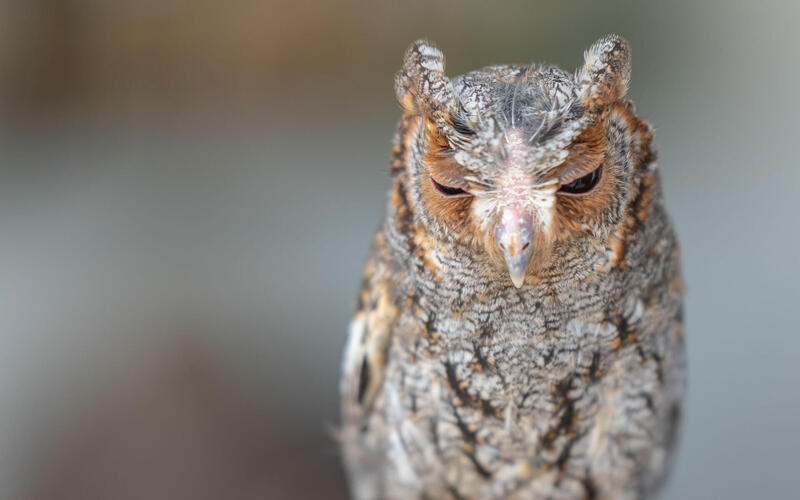
Flammulated Owl
Scientific Name: Otus flammeolus
Size: Small
Residency Type: Summer resident
Flammulated Owls are known to come to Texas in the summertime to breed in the mixed conifer-oak forests. The Trans-Pecos of Texas is its home of choice, including the Davis, the Guadalupe, and the Chisos Mountains. However, you might catch one in late March or April getting ready for the breeding season. Because of its migratory nature, which brings it to Mexico in the winter, the Flammulated Owl sometimes pops up in unexpected locations. It is known to be a pretty secretive creature, which makes it harder to spot and study. If you do see it, it is set apart by the flame-shaped marks on the top of the wings. Do not mistake it for the Eastern Screech-Owl or the Western Screech-Owl, because its eyes are black and it has almost invisible ear tufts.
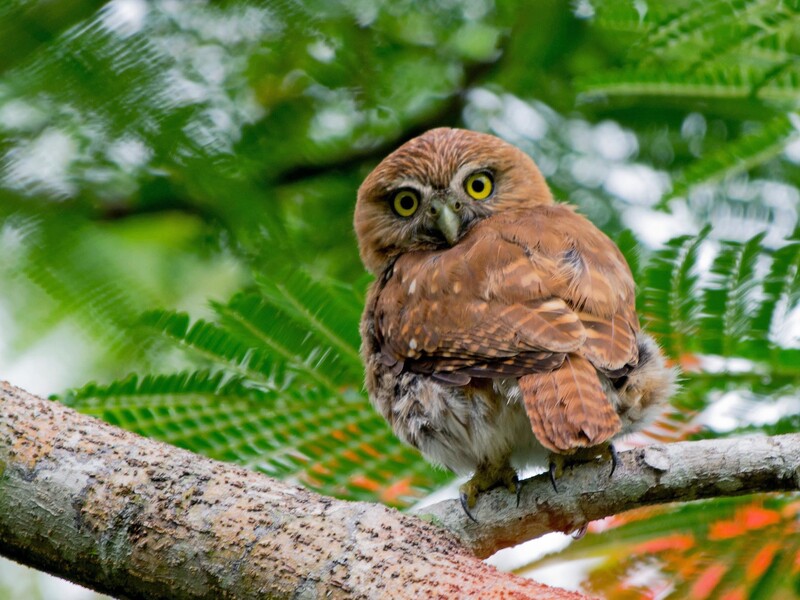
Ferruginous Pygmy-Owl
Scientific Name: Glaucidium brasilianum
Size: Small
Residency Type: Permanent residents (only in the southern part of the state)
The cute Ferruginous Pygmy-Owl has several unique characteristics, including a long tail. This species of owl is active in the daylight hours, which is very unusual for most owls. Habitat loss in Texas has restricted the range of this species to the live oak-honey mesquite forest in the historic Wild Horse Desert. They are considered a threatened species in the United States due to their loss of habitat. They have a lot of ingenuity and make their nests out of cavities in live oak trees. Despite its tiny stature, the Ferruginous Pygmy-Owl can be very bold and aggressive. This boldness can be seen when it hunts, which involves waiting for the right moment to strike.

Northern Saw-whet Owl
Scientific Name: Aegolius acadicus
Size: Small
Residency Type: Summer resident
Although the Northern Saw-whet Owl is not a common sight in Texas, it has been recorded as a rare summer resident. Keep an eye out for this owl if you are in the area of the Guadalupe mountains of Trans-Pecos, Texas. You will know a Northern Saw-whet Owl from its call, which is similar to the sound of a saw being sharpened on a whetstone. Do not be discouraged if you can’t locate it despite hearing its distinct call. This species of owl is known to be very good at avoiding notice. It usually makes coniferous forests their home.
Related
- Interested in birding? Learn more about how you can get started by visiting our guide: Beginners Guide To Birding
- Among other birds, owls can make some very interesting sounds. Learn more about how you can improve your earbirding skills and identify other birds in How To Identify Birds By Their Sounds
Leave a Reply